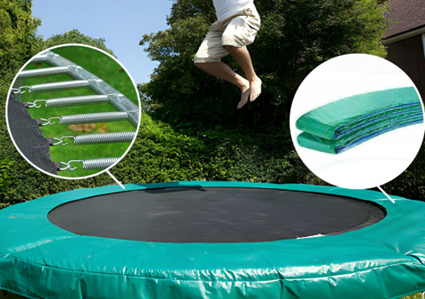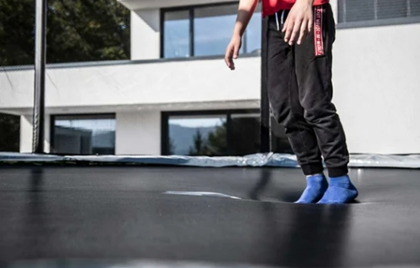Behind the Bounce: What Are Trampolines Made Of?
Trampolines are an iconic source of fun and fitness, enjoyed by people of all ages. While most users focus on the fun of bouncing, few consider the critical materials that make up these recreational devices. What are trampolines made of? Each component, from the frame to the springs and safety pads, plays a significant role in ensuring durability, safety, and a smooth, enjoyable experience. This guide explores the materials behind the bounce of trampolines, helping you understand what makes them such effective fitness tools and why choosing the right materials is key to longevity and performance.
What Are Trampolines Made Of? A Look at Key Materials
A trampoline’s performance, safety, and durability depend on the materials used in its construction. Key components like the frame, springs, jumping mat, and safety pads are crafted from high-quality materials that ensure strength, flexibility, and resilience. The frame, typically made from steel, provides stability, while the springs, often crafted from galvanized steel or stainless steel, determine the bounce’s quality. The mat, usually made from polypropylene or UV-resistant fabrics, adds comfort and consistency. The safety pads are designed to prevent injuries, covering sharp edges and springs with cushioning materials like foam and vinyl. Each of these components plays an essential role in the trampoline’s overall performance, safety, and longevity. When buying a trampoline, understanding these materials can help you make a more informed purchase.
The Trampoline Frame
Steel vs. Galvanized Steel: Which Is Better?
The frame is the backbone of the trampoline, providing structure and stability. Most trampoline frames are made from either standard steel or galvanized steel. Standard steel is durable but susceptible to rust when exposed to the elements. Galvanized steel, on the other hand, undergoes a special process where it is coated with a layer of zinc to prevent rusting. This makes galvanized steel much more resistant to corrosion, making it a preferred option for outdoor trampolines. The corrosion-resistant properties of galvanized steel increase the frame's lifespan, especially in areas with high humidity or rain, ensuring that the trampoline can withstand harsh weather conditions without losing its strength.
How Frame Material Affects Stability and Safety
The frame material significantly impacts the trampoline's stability and overall safety. A sturdy frame that is well-constructed ensures that the trampoline remains stable during use, preventing any wobbling or risk of collapse. Heavy-duty frames made from galvanized steel offer more strength and stability, particularly when multiple people are bouncing at the same time. Stability is essential not just for safety, but also for the bounce quality, as a sturdy frame ensures consistent performance. A reliable frame also helps prevent wear and tear from regular use, which contributes to the overall safety and longevity of the trampoline.
Trampoline Springs
Spring Material Choices: Galvanized Steel vs. Stainless Steel
Trampoline springs are integral to providing the bounce. The choice of material for the springs can significantly impact the trampoline's performance. Galvanized steel springs are coated with a layer of zinc, making them resistant to rust and capable of withstanding outdoor exposure. These springs are a popular choice for outdoor trampolines due to their durability and rust resistance. On the other hand, stainless steel springs are known for their superior strength and longevity. While they are typically more expensive, stainless steel springs are less prone to fatigue over time, offering a longer-lasting and more consistent bounce. The choice of spring material depends on your budget and how frequently the trampoline will be used.
The Role of Springs in Bounce and Safety
Springs are the key to the trampoline’s bounce. The tension and number of springs determine how high and smooth the bounce will be. Quality springs enhance the jumping experience, providing a responsive and controlled bounce. High-quality springs allow for better energy transfer, resulting in higher and more enjoyable jumps. Moreover, springs also play a vital role in safety. Properly tensioned springs ensure a controlled landing, reducing the risk of injury. Springs absorb impact during the landing phase, helping to protect joints and muscles from strain. Therefore, the quality and condition of trampoline springs are essential for both performance and safety.

The Jumping Mat
Material Types: Polypropylene, UV-Resistant Fabric
The jumping mat is an essential component of the trampoline, as it provides the surface on which users bounce. High-quality trampoline mats are typically made from polypropylene, a strong and durable material that is resistant to wear and tear. Polypropylene mats are flexible and stretch under pressure, providing the ideal surface for a consistent bounce. Many mats are also made from UV-resistant fabrics to prevent degradation from prolonged exposure to sunlight. UV-resistant materials ensure that the mat retains its strength and color over time, even when left outdoors. Choosing a mat made from these materials ensures both durability and safety for users.
How the Mat Affects the Bounce Quality
The material of the jumping mat directly impacts the quality of the bounce. High-quality mats made from durable materials like polypropylene offer excellent stretchability, allowing users to experience a smoother, higher bounce. The consistency of the mat ensures that each jump is as predictable and enjoyable as the last. A well-constructed mat absorbs shock effectively, reducing the strain on the jumper’s body, especially the knees and ankles. Additionally, the mat’s tension and elasticity work with the springs to create a balanced and responsive bouncing experience. Therefore, choosing a mat with the right material and construction is critical for a high-quality trampoline workout or recreational experience.
Safety Pads and Other Features
Materials Used in Safety Pads: Foam, Vinyl, PVC
Safety pads are crucial for protecting jumpers from the trampoline’s frame and springs. These pads are usually made from foam for cushioning, with an outer layer of vinyl or PVC for durability. The foam inside the safety pads provides the necessary padding to absorb impacts and protect the user in case of a fall. The vinyl or PVC covering ensures that the pads remain durable and weather-resistant, even when exposed to outdoor elements. Together, these materials offer both comfort and protection, reducing the risk of injury. The combination of these materials in safety pads ensures that they remain effective throughout the trampoline’s lifespan, safeguarding users while they enjoy their jumps.
Importance of Properly Secured Safety Features
Properly securing safety pads and other features is essential for maintaining a safe trampoline experience. Loose or improperly attached safety pads can become a hazard, potentially detaching during use and exposing users to the frame or springs. Ensuring that the safety pads are correctly installed and tightly secured helps prevent these risks. Regular checks and maintenance of safety features are necessary to ensure that they are intact and functioning properly. Ensuring the proper alignment and attachment of safety features adds an extra layer of security, keeping users safe while they enjoy their trampoline experience.
Conclusion
Understanding the materials used in trampoline construction provides insight into their quality, safety, and longevity. The materials in the frame, springs, mat, and safety pads are carefully chosen for their durability and performance. By selecting trampolines with high-quality materials, you ensure a better bounce experience and enhanced safety. What are trampolines made of? Whether you're purchasing a new trampoline or maintaining an existing one, knowing what your trampoline is made of can guide you in making informed decisions. Quality materials lead to safer, longer-lasting trampolines, ensuring years of enjoyment for users of all ages.
FAQ
How long do trampolines typically last?
The lifespan of a trampoline depends on its quality and maintenance. Generally, a well-maintained trampoline can last between 5 to 10 years. Regularly checking and replacing worn-out parts like springs, mats, and safety pads can extend its life.
Can trampolines be repaired if damaged?
Yes, trampolines can be repaired if damaged. Replacement parts for frames, springs, mats, and safety pads are widely available. Addressing any damage promptly helps maintain safety and prolongs the trampoline’s overall lifespan.
Are trampolines safe for children?
Trampolines can be safe for children if used properly and supervised. Ensuring that the trampoline has adequate safety features, such as padded frames and safety nets, reduces the risk of accidents. Always follow recommended safety guidelines to keep jumping fun and safe.









